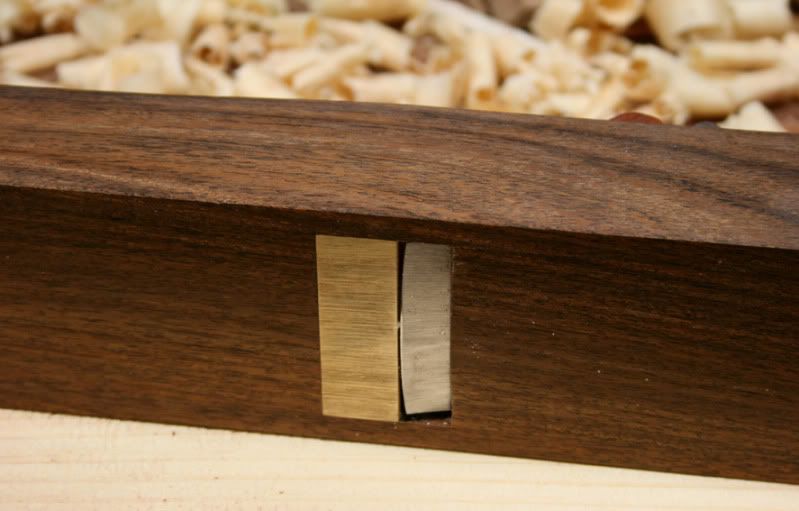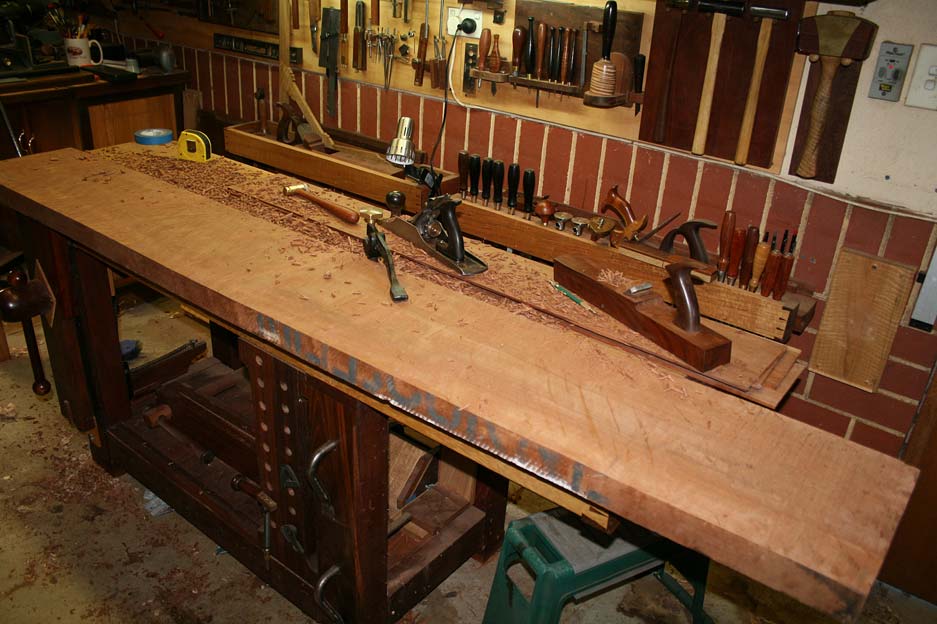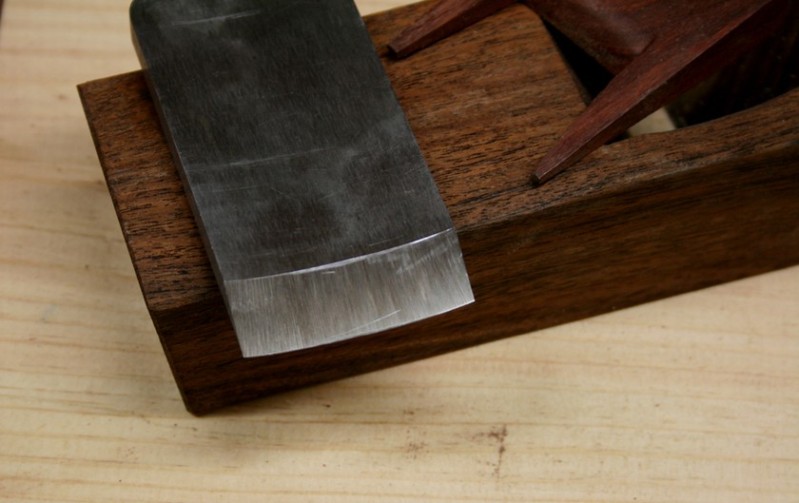 Needs Pictures: 0
Needs Pictures: 0
 Picture(s) thanks: 0
Picture(s) thanks: 0
Results 16 to 30 of 48
Thread: Recommend me a Jack Plane?
-
1st September 2015, 10:13 PM #16

Holy crap ! You need a laptop beside that lot to help you choose which one to use ! Put in timber type, dimensions and task and the laptop would engage a robotic arm to select the correct plane for you.
I would have no chance of remembering which plane is set up which way, and would probably end up using about 4 of them.Glenn Visca
-
1st September 2015 10:13 PM # ADSGoogle Adsense Advertisement
- Join Date
- Always
- Location
- Advertising world
- Age
- 2010
- Posts
- Many
-
2nd September 2015, 09:11 AM #17

Nah, you just work your way through from left to right until you find one that's actually sharp!

At least that's what I did when had far too many bench planes - I'd end up using the one I liked until it was dull, then the next one, until I had a dozen dull blades and a looming case of RSI from the following sharpening session. So I kicked the habit of picking up old planes at flea markets, got rid of the excess, and now have 3 or 4 that are always ready to go because they all get used regularly & sharpened regularly...
You can see by the replies that there is a wide range of opinions on what planes you 'must' have. The truth is, different planes do the same jobs in different hands, and it's really a matter of first finding out what size(s) you like to use. We'll leave questions like which way you want your blade bevels and other matters of construction for later discussions.. The best way to do that is to get your hands on a plane, e.g., one of the more common 'bench' planes (4s & 5s are far & away the most likely to present themselves at a tool sale or flea market), and start using it. After a while, you'll find the answer to the question of which plane is 'best' for you (and if the experiences of the rest of us are anything to go by, there'll most likely be several answers!).
The best way to do that is to get your hands on a plane, e.g., one of the more common 'bench' planes (4s & 5s are far & away the most likely to present themselves at a tool sale or flea market), and start using it. After a while, you'll find the answer to the question of which plane is 'best' for you (and if the experiences of the rest of us are anything to go by, there'll most likely be several answers!). 
Cheers,IW
-
2nd September 2015, 05:52 PM #18
-
2nd September 2015, 07:46 PM #19
 GOLD MEMBER
GOLD MEMBER











- Join Date
- Nov 2012
- Location
- SE Melb
- Age
- 64
- Posts
- 1,278

According to Chris Schwarz in the video below and in his books, he says the jack plane should have a curved iron for fast stock removal. Is that the same with most jack plane? I know mine isn't like that at all, probably indicating mine is more like a 14" smoothing plane.http://video.pbs.org/video/2172600556/
-
2nd September 2015, 08:16 PM #20

justonething, how you sharpen your blades is entirely up to you, & depends on what you use the plane for most. Certainly, a curved blade can remove stock quickly, especially if you push the plane at an angle to the grain (makes it far easier to push when taking deep cuts). However, when I had only one decent plane (a #5), it truly had to be a jack of all trades, & I sharpened the blade square, with ever-so-lightly duffed corners. In fact, I'm not a fan of convex blades in any plane, and all of my planes are sharpened the same way, with the cutting edge straight & square. Other folks find curved blades suit their style, it's just my personal preference....
Cheers,IW
-
2nd September 2015, 08:45 PM #21

CS is absolutely correct. But this is part of the story - the essential element is that planes work together as a team. Jack (coarse), Joiner (Medium) and Smoother (Fine). You can set up a #4 as a jack plane (as done by Paul Sellars), but it MUST have a curved blade. The #5 is the traditional jack plane. However a #6 is often used in this format as well.
I have two jack planes. One is a woodie I built, and the other is a metal plane, a Bed Rock #605 ...
Look at the blade. This is an 8" radius. It is the same on both planes ..


Here are the two jacks I have preparing a board ...

The jack is followed by the jointer, and finally by the smoother. Do it right (most of the work is done by the jack) and there is little smoothing to do. Do it wrong (leave most of the work for the smoother) and you will be planing forever.
Regards from Perth
DerekVisit www.inthewoodshop.com for tutorials on constructing handtools, handtool reviews, and my trials and tribulations with furniture builds.
-
2nd September 2015, 10:55 PM #22
 GOLD MEMBER
GOLD MEMBER











- Join Date
- Nov 2012
- Location
- SE Melb
- Age
- 64
- Posts
- 1,278

I presume that a new iron is straight and I'll need to re-grind it to a curvature and then hone it sharp if I want to. Is there a jig for that or do I have to learn how to do it free hand.
-
2nd September 2015, 11:22 PM #23

1. Draw an 8" circle, and transfer this radius to the bevel end of the blade.
2. Grind to the edge of the radius - but do so such that the edge is at 90 degrees. You do not add the bevel yet. (The reason for this is that the grind to the edge will burn the thin steel).
You can grind with either a bench grinder or belt sander. Just keep wetting the edge to cool it.
3. Now the bevel can be ground. I hollow grind at 30 degrees on an 8" grinder and then hone on this. You could stop a little short of the edge and then use a honing guide as well. Anything 30 - 35 degrees will be good.

Regards from Perth
DerekVisit www.inthewoodshop.com for tutorials on constructing handtools, handtool reviews, and my trials and tribulations with furniture builds.
-
3rd September 2015, 04:34 AM #24
 Member
Member











- Join Date
- Mar 2015
- Location
- toronto, canada
- Posts
- 61

Funny - just in time - today post https://paulsellers.com/2015/09/surp...by-a-question/
-
3rd September 2015, 12:52 PM #25
 GOLD MEMBER
GOLD MEMBER











- Join Date
- Nov 2012
- Location
- SE Melb
- Age
- 64
- Posts
- 1,278
-
3rd September 2015, 09:55 PM #26
 Yes, if using a guide.to hone a curved blade? Do I rock from side to side while I push forward and back?
Yes, if using a guide.to hone a curved blade? Do I rock from side to side while I push forward and back?
Or, if hollow ground, freehand on the hollow.
Regards from Perth
DerekVisit www.inthewoodshop.com for tutorials on constructing handtools, handtool reviews, and my trials and tribulations with furniture builds.
-
3rd September 2015, 10:48 PM #27
 GOLD MEMBER
GOLD MEMBER

- Join Date
- Jun 2014
- Location
- Seattle, Washington, USA
- Posts
- 1,857

Derek, you're the man, and your knowledge of woodworking is millenia beyond my own.
But this guy is trying to own one, single plane. Cambering the iron helps remove stock more quickly, yes. Definitely. But a plane with a cambered iron is useless when you're trying to get a finished surface, especially one with an 8" radius. I grind a 9.25" radius and it still leaves trenches when used along the grain.
A jack plane does not NEED a cambered iron. It benefits from one. I have a cambered iron/breaker setup on hand at all times and, as mentioned in a previous post of mine, it is great to have, especially when you don't have any machines. I certainly suggest having one, but having the cambered iron is not what makes a jack plane a jack plane. It is called that because it can do multiple tasks as efficiently as other planes when used properly. Yes, initial flattening (coarse) is one of them, but jointing (medium) and smoothing (fine) are also tasks which can be performed by a jack plane, but not one with a cambered iron.
A straight iron, on the other hand, while not as good as a cambered iron, can be used to achieve initial flattening.
Schwarz is suggesting a jack plane with a default cambered iron for a person who owns multiple planes. If you watch the video where he goes through his own tool chest, the first thing he pulls out is his jack plane, and the last thing he says about it is that, while he keeps a cambered iron in it by default, he always has a straight iron and chip breaker on hand which he can quickly insert for smoothing and jointing.
justonething, the reason Schwarz keeps the cambered iron in the plane by default is because he owns many planes. Everything he and Derek say about the value of the cambered iron, as well as how to achieve it, is spot on. However, I, as a woodworker who uses both regularly, definitely would very much steer you away from only having a cambered iron. Start with a straight iron and, if your boards are way out of flat, consider getting a second iron/chip breaker combo and putting a camber on the iron. Having both of these setups available is the difference between having a #5 plane and having a jack plane.
Unless of course, you have now changed your mind and you intend to buy a #7 and a #4 as well. In that case, curve it like a banana.
My AU$0.02.
Cheers,
Luke
-
3rd September 2015, 11:01 PM #28

Hi Luke
Thanks for the compliment. It is true that I know more about handplanes than anyone else alive.
Luke, we are essentially saying the same thing. These are options. The problem is that the advice we give will overload the OP. It is all correct, but not necessarily practical in the limited setting.
The OP asked which plane to purchase, and whether he should get a #5. I simply pointed out that, ideally, planes work as a system. There are pros and cons to a #5 with a straight blade. As you note, there are pros and cons to a #5 with a cambered blade. I would argue, however, that only owning and using a #5 with a straight blade is going to be too hard for rough work.
Why did the OP ask about purchasing one plane? Perhaps he is unaware that he can pick up a #5 and a #4 together for very little. There are cheap planes on eBay. Indeed, should he do so, he has a combination that could do a lot of work on small work. Two blades for the #5 (cambered for Rough work and straight for Medium work), and a #4 (or #3) for the Fine smoothing.
Regards from Perth
DerekVisit www.inthewoodshop.com for tutorials on constructing handtools, handtool reviews, and my trials and tribulations with furniture builds.
-
3rd September 2015, 11:14 PM #29
 GOLD MEMBER
GOLD MEMBER

- Join Date
- Jun 2014
- Location
- Seattle, Washington, USA
- Posts
- 1,857
-
4th September 2015, 10:28 AM #30

Just a small sidestep, Derek is that a photo of the sidewall of your Lingerie chest build, prior to shaping it to a curved concave/ convex piece? and if so did you do that entirely with hand planes?It would be to wide to fit through our smaller bandsaws. if hand planed it is a mammoth task ,needing high skills and patience, the shavings would weigh10ks and fill a bathtub or maybe I'm unaware of the speed of your cambered plane, Rossco
Similar Threads
-
Can I trim a #6 hand plane & use as a #5 1/2 jack plane? Your opinion needed
By woodhog in forum WOODWORK - GENERALReplies: 9Last Post: 16th May 2017, 12:32 AM -
Veritas 5-1/4 Bench Plane Vs Low-Angle Jack Plane
By Wolfs in forum HAND TOOLS - UNPOWEREDReplies: 10Last Post: 30th April 2008, 01:43 PM -
Jack plane converted to scrub plane...???
By Greg_stewy in forum HAND TOOLS - UNPOWEREDReplies: 4Last Post: 7th June 2007, 10:59 AM -
Jack Plane
By Pete in forum HAND TOOLS - UNPOWEREDReplies: 1Last Post: 14th June 2001, 06:26 PM



 Thanks:
Thanks:  Likes:
Likes: 

 Reply With Quote
Reply With Quote to hone a curved blade? Do I rock from side to side while I push forward and back?
to hone a curved blade? Do I rock from side to side while I push forward and back?